2020 CHEVROLET BOLT EV climate control
[x] Cancel search: climate controlPage 172 of 347
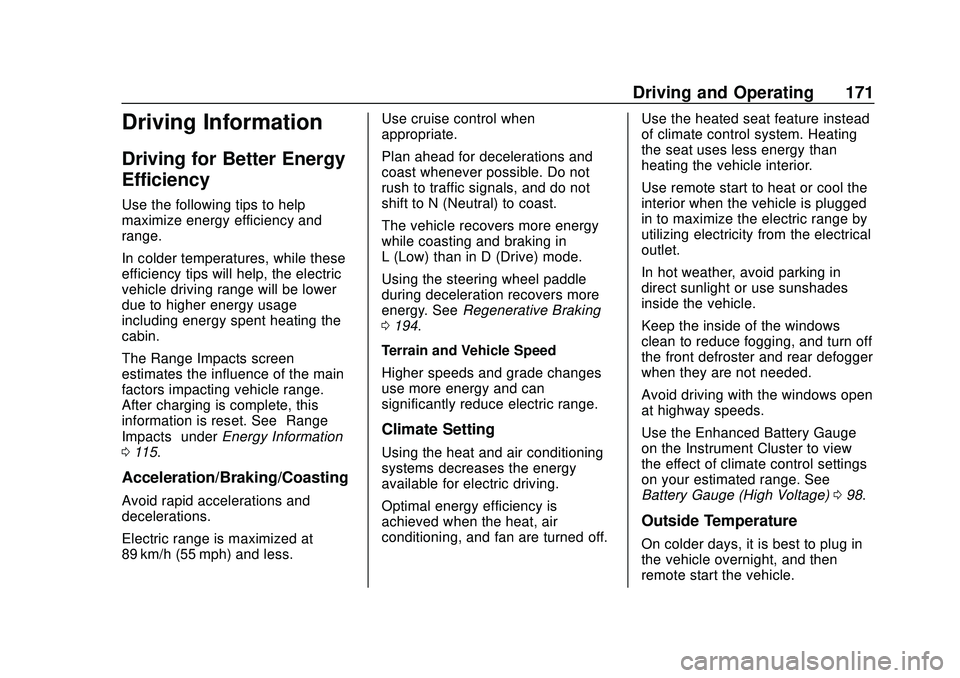
Chevrolet BOLT EV Owner Manual (GMNA-Localizing-U.S./Canada/Mexico-
13556250) - 2020 - CRC - 2/11/20
Driving and Operating 171
Driving Information
Driving for Better Energy
Efficiency
Use the following tips to help
maximize energy efficiency and
range.
In colder temperatures, while these
efficiency tips will help, the electric
vehicle driving range will be lower
due to higher energy usage
including energy spent heating the
cabin.
The Range Impacts screen
estimates the influence of the main
factors impacting vehicle range.
After charging is complete, this
information is reset. See“Range
Impacts” underEnergy Information
0 115.
Acceleration/Braking/Coasting
Avoid rapid accelerations and
decelerations.
Electric range is maximized at
89 km/h (55 mph) and less. Use cruise control when
appropriate.
Plan ahead for decelerations and
coast whenever possible. Do not
rush to traffic signals, and do not
shift to N (Neutral) to coast.
The vehicle recovers more energy
while coasting and braking in
L (Low) than in D (Drive) mode.
Using the steering wheel paddle
during deceleration recovers more
energy. See
Regenerative Braking
0 194.
Terrain and Vehicle Speed
Higher speeds and grade changes
use more energy and can
significantly reduce electric range.
Climate Setting
Using the heat and air conditioning
systems decreases the energy
available for electric driving.
Optimal energy efficiency is
achieved when the heat, air
conditioning, and fan are turned off. Use the heated seat feature instead
of climate control system. Heating
the seat uses less energy than
heating the vehicle interior.
Use remote start to heat or cool the
interior when the vehicle is plugged
in to maximize the electric range by
utilizing electricity from the electrical
outlet.
In hot weather, avoid parking in
direct sunlight or use sunshades
inside the vehicle.
Keep the inside of the windows
clean to reduce fogging, and turn off
the front defroster and rear defogger
when they are not needed.
Avoid driving with the windows open
at highway speeds.
Use the Enhanced Battery Gauge
on the Instrument Cluster to view
the effect of climate control settings
on your estimated range. See
Battery Gauge (High Voltage)
098.
Outside Temperature
On colder days, it is best to plug in
the vehicle overnight, and then
remote start the vehicle.
Page 173 of 347
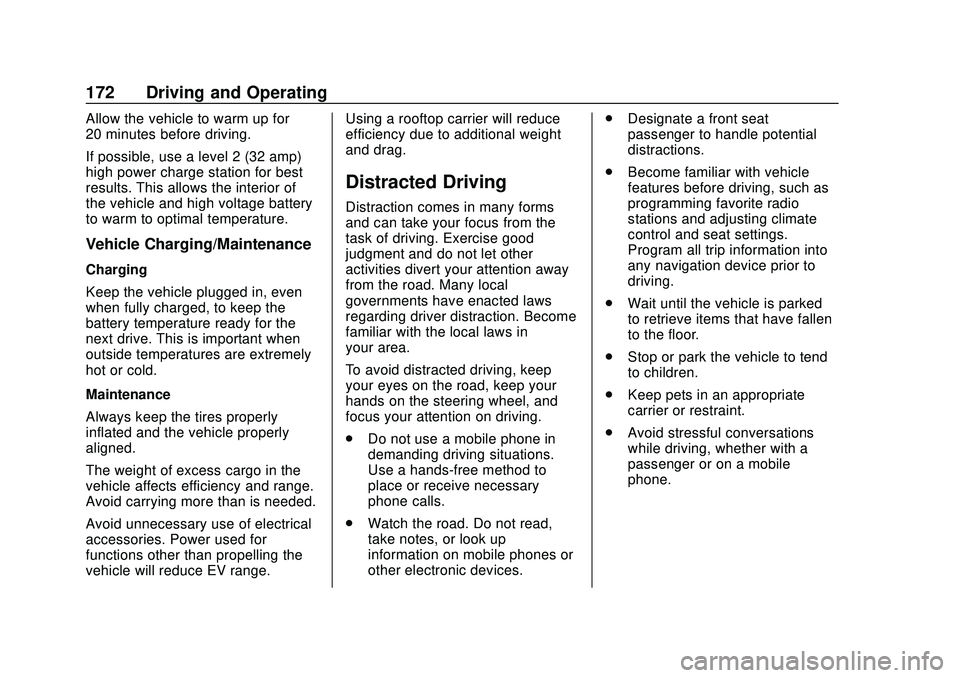
Chevrolet BOLT EV Owner Manual (GMNA-Localizing-U.S./Canada/Mexico-
13556250) - 2020 - CRC - 2/11/20
172 Driving and Operating
Allow the vehicle to warm up for
20 minutes before driving.
If possible, use a level 2 (32 amp)
high power charge station for best
results. This allows the interior of
the vehicle and high voltage battery
to warm to optimal temperature.
Vehicle Charging/Maintenance
Charging
Keep the vehicle plugged in, even
when fully charged, to keep the
battery temperature ready for the
next drive. This is important when
outside temperatures are extremely
hot or cold.
Maintenance
Always keep the tires properly
inflated and the vehicle properly
aligned.
The weight of excess cargo in the
vehicle affects efficiency and range.
Avoid carrying more than is needed.
Avoid unnecessary use of electrical
accessories. Power used for
functions other than propelling the
vehicle will reduce EV range.Using a rooftop carrier will reduce
efficiency due to additional weight
and drag.
Distracted Driving
Distraction comes in many forms
and can take your focus from the
task of driving. Exercise good
judgment and do not let other
activities divert your attention away
from the road. Many local
governments have enacted laws
regarding driver distraction. Become
familiar with the local laws in
your area.
To avoid distracted driving, keep
your eyes on the road, keep your
hands on the steering wheel, and
focus your attention on driving.
.
Do not use a mobile phone in
demanding driving situations.
Use a hands-free method to
place or receive necessary
phone calls.
. Watch the road. Do not read,
take notes, or look up
information on mobile phones or
other electronic devices. .
Designate a front seat
passenger to handle potential
distractions.
. Become familiar with vehicle
features before driving, such as
programming favorite radio
stations and adjusting climate
control and seat settings.
Program all trip information into
any navigation device prior to
driving.
. Wait until the vehicle is parked
to retrieve items that have fallen
to the floor.
. Stop or park the vehicle to tend
to children.
. Keep pets in an appropriate
carrier or restraint.
. Avoid stressful conversations
while driving, whether with a
passenger or on a mobile
phone.
Page 239 of 347
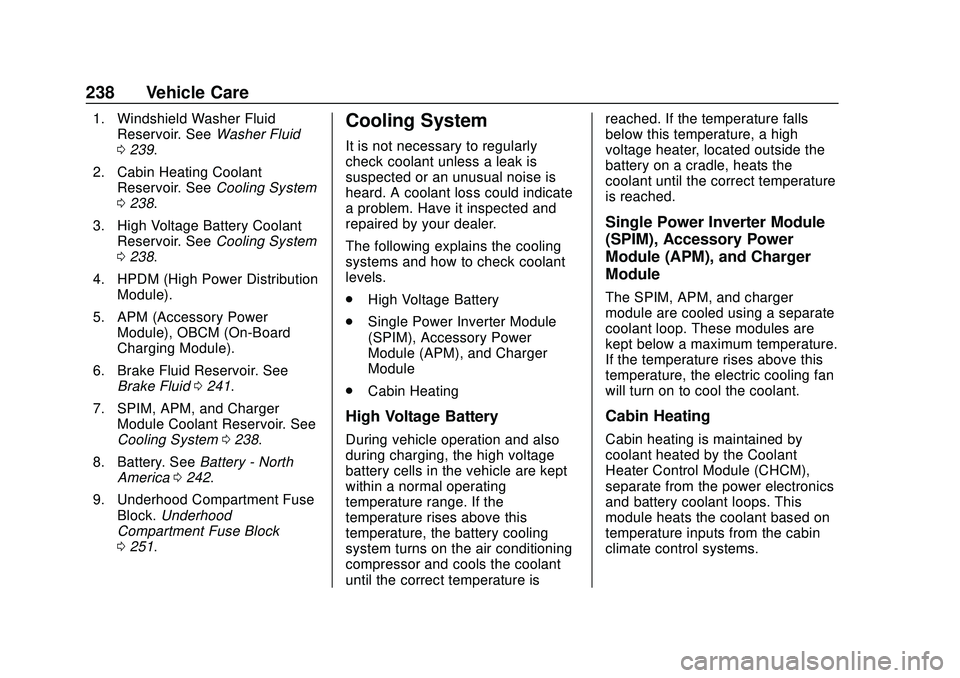
Chevrolet BOLT EV Owner Manual (GMNA-Localizing-U.S./Canada/Mexico-
13556250) - 2020 - CRC - 2/11/20
238 Vehicle Care
1. Windshield Washer FluidReservoir. See Washer Fluid
0 239.
2. Cabin Heating Coolant Reservoir. See Cooling System
0 238.
3. High Voltage Battery Coolant Reservoir. See Cooling System
0 238.
4. HPDM (High Power Distribution Module).
5. APM (Accessory Power Module), OBCM (On-Board
Charging Module).
6. Brake Fluid Reservoir. See Brake Fluid 0241.
7. SPIM, APM, and Charger Module Coolant Reservoir. See
Cooling System 0238.
8. Battery. See Battery - North
America 0242.
9. Underhood Compartment Fuse Block. Underhood
Compartment Fuse Block
0 251.Cooling System
It is not necessary to regularly
check coolant unless a leak is
suspected or an unusual noise is
heard. A coolant loss could indicate
a problem. Have it inspected and
repaired by your dealer.
The following explains the cooling
systems and how to check coolant
levels.
.
High Voltage Battery
. Single Power Inverter Module
(SPIM), Accessory Power
Module (APM), and Charger
Module
. Cabin Heating
High Voltage Battery
During vehicle operation and also
during charging, the high voltage
battery cells in the vehicle are kept
within a normal operating
temperature range. If the
temperature rises above this
temperature, the battery cooling
system turns on the air conditioning
compressor and cools the coolant
until the correct temperature is reached. If the temperature falls
below this temperature, a high
voltage heater, located outside the
battery on a cradle, heats the
coolant until the correct temperature
is reached.
Single Power Inverter Module
(SPIM), Accessory Power
Module (APM), and Charger
Module
The SPIM, APM, and charger
module are cooled using a separate
coolant loop. These modules are
kept below a maximum temperature.
If the temperature rises above this
temperature, the electric cooling fan
will turn on to cool the coolant.
Cabin Heating
Cabin heating is maintained by
coolant heated by the Coolant
Heater Control Module (CHCM),
separate from the power electronics
and battery coolant loops. This
module heats the coolant based on
temperature inputs from the cabin
climate control systems.
Page 275 of 347
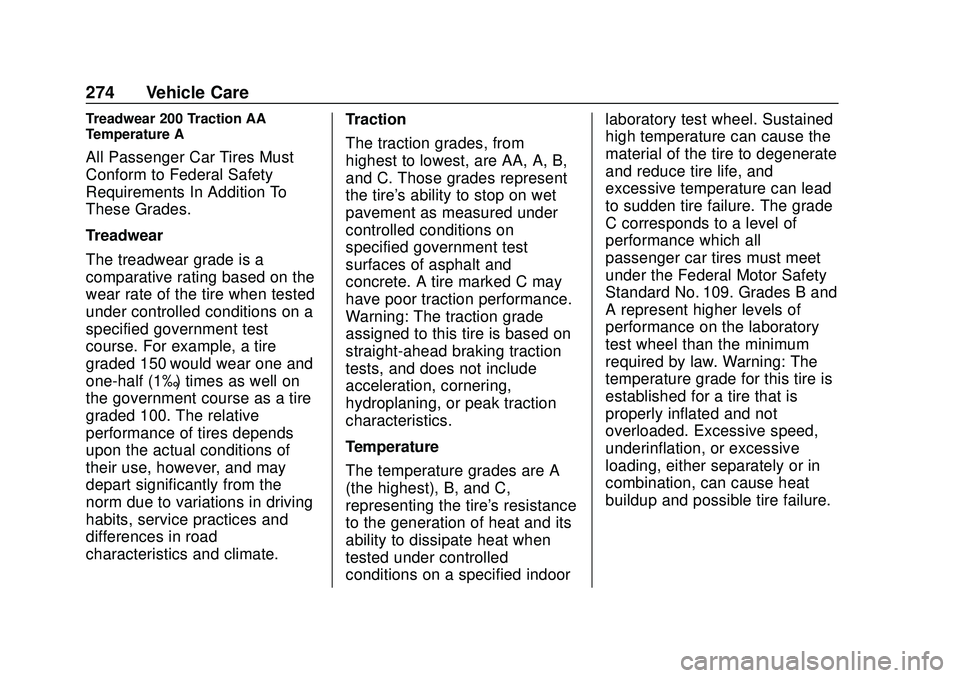
Chevrolet BOLT EV Owner Manual (GMNA-Localizing-U.S./Canada/Mexico-
13556250) - 2020 - CRC - 2/11/20
274 Vehicle Care
Treadwear 200 Traction AA
Temperature A
All Passenger Car Tires Must
Conform to Federal Safety
Requirements In Addition To
These Grades.
Treadwear
The treadwear grade is a
comparative rating based on the
wear rate of the tire when tested
under controlled conditions on a
specified government test
course. For example, a tire
graded 150 would wear one and
one-half (1½) times as well on
the government course as a tire
graded 100. The relative
performance of tires depends
upon the actual conditions of
their use, however, and may
depart significantly from the
norm due to variations in driving
habits, service practices and
differences in road
characteristics and climate.Traction
The traction grades, from
highest to lowest, are AA, A, B,
and C. Those grades represent
the tire's ability to stop on wet
pavement as measured under
controlled conditions on
specified government test
surfaces of asphalt and
concrete. A tire marked C may
have poor traction performance.
Warning: The traction grade
assigned to this tire is based on
straight-ahead braking traction
tests, and does not include
acceleration, cornering,
hydroplaning, or peak traction
characteristics.
Temperature
The temperature grades are A
(the highest), B, and C,
representing the tire's resistance
to the generation of heat and its
ability to dissipate heat when
tested under controlled
conditions on a specified indoorlaboratory test wheel. Sustained
high temperature can cause the
material of the tire to degenerate
and reduce tire life, and
excessive temperature can lead
to sudden tire failure. The grade
C corresponds to a level of
performance which all
passenger car tires must meet
under the Federal Motor Safety
Standard No. 109. Grades B and
A represent higher levels of
performance on the laboratory
test wheel than the minimum
required by law. Warning: The
temperature grade for this tire is
established for a tire that is
properly inflated and not
overloaded. Excessive speed,
underinflation, or excessive
loading, either separately or in
combination, can cause heat
buildup and possible tire failure.
Page 337 of 347

Chevrolet BOLT EV Owner Manual (GMNA-Localizing-U.S./Canada/Mexico-
13556250) - 2020 - CRC - 2/11/20
336 Index
ArmrestRear Seat . . . . . . . . . . . . . . . . . . . . . . 38
Assistance Program, Roadside . . . . . . . . . . . . . . . . . . . . . . 316
Assistance Systems for Driving . . . . . . . . . . . . . . . . . . . . . . . . 203
Assistance Systems for
Parking and Backing . . . . . . . . . . 200
Audio Bluetooth . . . . . . . . . . . . . . . . . . . . . 150
Theft-Deterrent Feature . . . . . . . 136
Automatic Climate Control System . . . . . . . 163
Door Locks . . . . . . . . . . . . . . . . . . . . . 19
Emergency Braking (AEB) . . . . 205
Headlamp System . . . . . . . . . . . . 131
Auxiliary Devices . . . . . . . . . . . . . . . . . . . . . . . 149
B
Battery . . . . . . . . . . . . . . . . . . . . . . . . . . 98Exterior Lighting BatterySaver . . . . . . . . . . . . . . . . . . . . . . . 134
Power Protection . . . . . . . . . . . . . 134
Battery - North America . . . . 242, 284
Battery Gauge High Voltage . . . . . . . . . . . . . . . . . . . . 98
Blade Replacement, Wiper . . . . . 244 Bluetooth
Overview . . . . . . . . . . . . . . . . . . . . . 153
Bluetooth Audio . . . . . . . . . . . . . . . . 150
Brake Parking, Electric . . . . . . . . . . . . . . 192
System Warning Light . . . . . . . . 102
Brakes . . . . . . . . . . . . . . . . . . . . . . . . . . 240
Antilock . . . . . . . . . . . . . . . . . . . . . . . 191
Assist . . . . . . . . . . . . . . . . . . . . . . . . . 193
Fluid . . . . . . . . . . . . . . . . . . . . . . . . . . 241
Regenerative Braking . . . . . . . . . 194
Braking . . . . . . . . . . . . . . . . . . . . . . . . . 173 AutomaticEmergency (AEB) . . . . . . . . . . . 205
Braking System Front Pedestrian (FPB) . . . . . . . 207
Break-In, New Vehicle . . . . . . . . . . 182
Bulb Replacement Halogen Bulbs . . . . . . . . . . . . . . . . 247
Headlamp Aiming . . . . . . . . . . . . . 247
Headlamps . . . . . . . . . . . . . . . . . . . 247
High Intensity Discharge(HID) Lighting . . . . . . . . . . . . . . . 248
License Plate Lamps . . . . . . . . . 249
Taillamps, Turn Signal, Stoplamps, and Back-up
Lamps . . . . . . . . . . . . . . . . . . . . . . 248
Buying New Tires . . . . . . . . . . . . . . . 271
C
Calibration . . . . . . . . . . . . . . . . . . . . . . . 89
California Perchlorate MaterialsRequirements . . . . . . . . . . . . . . . 234
California Proposition
65 Warning . . . . . . . . . .233, 242, 284, Back Cover
Canadian Vehicle Owners . . . . . . . . 2
Capacities and
Specifications . . . . . . . . . . . . . . . . . 311
Carbon Monoxide Liftgate . . . . . . . . . . . . . . . . . . . . . . . . . 21
Winter Driving . . . . . . . . . . . . . . . . 177
Cargo Cover . . . . . . . . . . . . . . . . . . . . . . . . . . . 82
Management System . . . . . . . . . . . 83
Caution, Danger, and Warning . . . . 2
Center Console Storage . . . . . . . . . 82
Chains, Tire . . . . . . . . . . . . . . . . . . . . 276
Charge Cord . . . . . . . . . . . . . . . . . . . . 222
Charging Delay Override . . . . . . . . . . . . . . . 217
Electrical Requirements . . . . . . 229
Plug-In . . . . . . . . . . . . . . . . . . . . . . . 214
Programmable . . . . . . . . . . . . . . . . 107
Utility Interruption . . . . . . . . . . . . . 228
Page 338 of 347
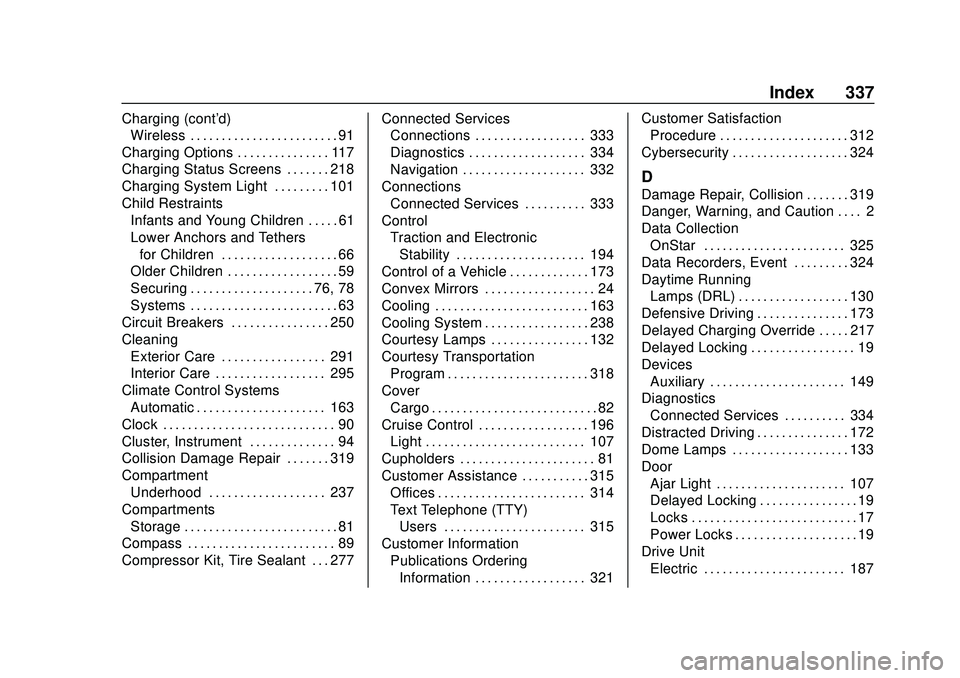
Chevrolet BOLT EV Owner Manual (GMNA-Localizing-U.S./Canada/Mexico-
13556250) - 2020 - CRC - 2/11/20
Index 337
Charging (cont'd)Wireless . . . . . . . . . . . . . . . . . . . . . . . . 91
Charging Options . . . . . . . . . . . . . . . 117
Charging Status Screens . . . . . . . 218
Charging System Light . . . . . . . . . 101
Child Restraints Infants and Young Children . . . . . 61
Lower Anchors and Tethers
for Children . . . . . . . . . . . . . . . . . . . 66
Older Children . . . . . . . . . . . . . . . . . . 59
Securing . . . . . . . . . . . . . . . . . . . . 76, 78
Systems . . . . . . . . . . . . . . . . . . . . . . . . 63
Circuit Breakers . . . . . . . . . . . . . . . . 250
Cleaning Exterior Care . . . . . . . . . . . . . . . . . 291
Interior Care . . . . . . . . . . . . . . . . . . 295
Climate Control Systems Automatic . . . . . . . . . . . . . . . . . . . . . 163
Clock . . . . . . . . . . . . . . . . . . . . . . . . . . . . 90
Cluster, Instrument . . . . . . . . . . . . . . 94
Collision Damage Repair . . . . . . . 319
Compartment Underhood . . . . . . . . . . . . . . . . . . . 237
Compartments Storage . . . . . . . . . . . . . . . . . . . . . . . . . 81
Compass . . . . . . . . . . . . . . . . . . . . . . . . 89
Compressor Kit, Tire Sealant . . . 277 Connected Services
Connections . . . . . . . . . . . . . . . . . . 333
Diagnostics . . . . . . . . . . . . . . . . . . . 334
Navigation . . . . . . . . . . . . . . . . . . . . 332
Connections Connected Services . . . . . . . . . . 333
Control
Traction and ElectronicStability . . . . . . . . . . . . . . . . . . . . . 194
Control of a Vehicle . . . . . . . . . . . . . 173
Convex Mirrors . . . . . . . . . . . . . . . . . . 24
Cooling . . . . . . . . . . . . . . . . . . . . . . . . . 163
Cooling System . . . . . . . . . . . . . . . . . 238
Courtesy Lamps . . . . . . . . . . . . . . . . 132
Courtesy Transportation Program . . . . . . . . . . . . . . . . . . . . . . . 318
Cover Cargo . . . . . . . . . . . . . . . . . . . . . . . . . . . 82
Cruise Control . . . . . . . . . . . . . . . . . . 196 Light . . . . . . . . . . . . . . . . . . . . . . . . . . 107
Cupholders . . . . . . . . . . . . . . . . . . . . . . 81
Customer Assistance . . . . . . . . . . . 315
Offices . . . . . . . . . . . . . . . . . . . . . . . . 314
Text Telephone (TTY)Users . . . . . . . . . . . . . . . . . . . . . . . 315
Customer Information Publications OrderingInformation . . . . . . . . . . . . . . . . . . 321 Customer Satisfaction
Procedure . . . . . . . . . . . . . . . . . . . . . 312
Cybersecurity . . . . . . . . . . . . . . . . . . . 324
D
Damage Repair, Collision . . . . . . . 319
Danger, Warning, and Caution . . . . 2
Data Collection OnStar . . . . . . . . . . . . . . . . . . . . . . . 325
Data Recorders, Event . . . . . . . . . 324
Daytime Running Lamps (DRL) . . . . . . . . . . . . . . . . . . 130
Defensive Driving . . . . . . . . . . . . . . . 173
Delayed Charging Override . . . . . 217
Delayed Locking . . . . . . . . . . . . . . . . . 19
Devices Auxiliary . . . . . . . . . . . . . . . . . . . . . . 149
Diagnostics Connected Services . . . . . . . . . . 334
Distracted Driving . . . . . . . . . . . . . . . 172
Dome Lamps . . . . . . . . . . . . . . . . . . . 133
Door Ajar Light . . . . . . . . . . . . . . . . . . . . . 107
Delayed Locking . . . . . . . . . . . . . . . . 19
Locks . . . . . . . . . . . . . . . . . . . . . . . . . . . 17
Power Locks . . . . . . . . . . . . . . . . . . . . 19
Drive Unit Electric . . . . . . . . . . . . . . . . . . . . . . . 187